Norwich - Discover The Medieval Treasures!
Norwich, a large city on the East Coast of England, the East Anglia, used to be the largest provincial town in England three centuries ago. Even today it remains prosperous and attractive with a beautiful mix of the old and the new. The old medieval sections of the city are preserved well in the centre of the town, outlined by remaining parts of the ancient city walls, enclosing a treasure trove of beautiful historic buildings; most notably The Norman Cathedral, medieval Guildhall and the Castle. The Cathedral and the Castle dominate the city, look up from any point and you are sure to see the spire of the Cathedral, it is the tallest one in the locality. This spire was a guiding star for me when I was in Norwich, I used to walk around a lot exploring places and always kept the Cathedral Spire to give me a sense of the direction. Norwich has a large number of churches from the medieval times. It is said that there used to be a church for every week and a pub for every day in the city. The city is now a bustling centre for agriculture and the contribution of the past is greatly valued and preserved lovingly. What appealed to the most was that Norwich is as modern as it is old, blending the two flavours really well.
The city gets its name Norwich from Northwic, one of the old Norman settlements by the Anglo-Saxons who first built their homes along the banks of the River Wensum in the heart of East Anglia. These settlements date to the period around 1066, during the Norman Conquest, which then grew and then formed the largest walled town in the medieval times.
Some of the interesting historic buildings in Norwich are:
Norwich Cathedral
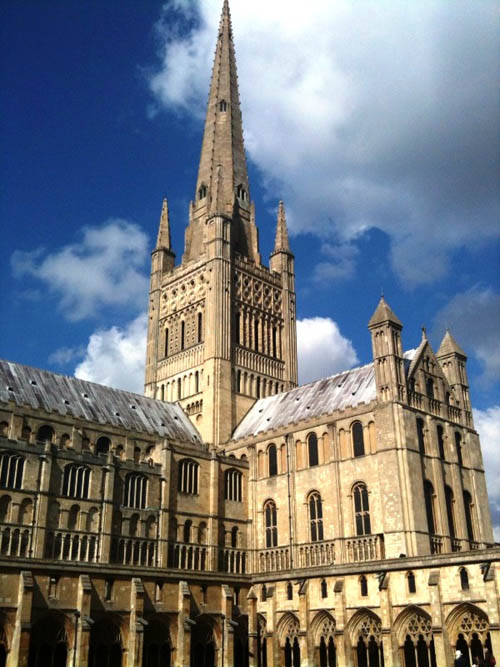 Standing majestically in the heart of the City, its spire dominates the city's skyline. It is still a living part of the city and services are held three times every day. The daily assembly of the neighbouring King Edward VI School also is held in The Cathedral, besides regular events such as various exhibitions, concerts, lectures etc. The construction of the Cathedral was started in 1096 and was finally consecrated in 1278. The building is made of beautiful honey-coloured Caen stone which is brought from Normandy, flintstones obtained locally and stone from Northamptonshire that were used later in additions to the building. The Spire that we see now is dated from 1463 after a lightning destroyed the original wooden roof and spire, and is 315 feet high. The Cathedral holds a beautiful and magnificent, huge organ that was built in 1938 after a succession of earlier organs were destroyed through the ceturies, mostly in fire but some were destroyed deliberately.
Standing majestically in the heart of the City, its spire dominates the city's skyline. It is still a living part of the city and services are held three times every day. The daily assembly of the neighbouring King Edward VI School also is held in The Cathedral, besides regular events such as various exhibitions, concerts, lectures etc. The construction of the Cathedral was started in 1096 and was finally consecrated in 1278. The building is made of beautiful honey-coloured Caen stone which is brought from Normandy, flintstones obtained locally and stone from Northamptonshire that were used later in additions to the building. The Spire that we see now is dated from 1463 after a lightning destroyed the original wooden roof and spire, and is 315 feet high. The Cathedral holds a beautiful and magnificent, huge organ that was built in 1938 after a succession of earlier organs were destroyed through the ceturies, mostly in fire but some were destroyed deliberately.
The Choir stalls are made from wood and the carvings are really intricate and delicate. The roof of the presbytery is fan-vaulted with delicate designs and are supported from massive Romanesque pillars and curved arches. This intricate fan vaulting is also seen in the roof of the medieval cloisters, the galleries that enclose a big, rectangular open space outside. The Prior's Door which links the cloisters with the Cathedral dates back to 1310 and is considered one of the many medieval treasures from the Cathedral.
Another great feature of the Cathedral are its stunning stained glass windows, especially the one in the Bauchon Lady Chapel which features the painting of the Cathedral and Bishop de Losinga, its founder.
Norwich Castle
Founded by William The Conqueror, it was built by the Normans as a Royal Palace between 1066 and 1075 and is considered as one of the finest secular buildings in Europe. It was used as the prison for 600 years and is now home to a fine museum since 4894, it is the principal museum of Norwich city. During the recent years, a lot of refurbishment was undertaken to showcase the Castle's history using a combination of original architectural features, models and hi-tech imagery. The visitors can explore the fighting galleries, spiral staircases, battlements, cellars, dungeons, basement, and communal latrines. The Norman section presents a sensational setting for displaying Norwich silver and Norwich Civic Regalia. The story of Queen Boudica and her Iceni tribe is retold in the museum through 2000-year-old gold torcs (neckbands), reconstructed Iceni chariot and reveals the contrasts between the East Anglicans and their Roman rulers. The museum also houses a large collection of ceramics, Lowestoft porcelain and natural history.
The other gallery is the art gallery which features works from 17th to 20th centuries, showcasing the works of Flemish painter Peter Tillemans, English watercolours, modern British paintings and Dutch landscapes.
The Castle also holds a large collection of butterflys.
Guildhall

Guildhall is a beautiful 15th-century building sporting a chequered design made of flints on the top of the east wall, the design is said to signify the
chequer table over which taxes used to be collected. The building used to be the seat of the government until early 20th century after which a new City Hall was constructed and the administration shifted to it. It now houses a few shops, coffee shop, and also is home to offices of the Norwich Heritage Economic and Regeneration Trust.
When it was built, every citizen was expected to contribute either by paying a special tax or by working on the building itself. There are underground cells for prisoners and three courtrooms which were in regular use until new courts were built at Bishopsgate in the 1980s.
The Close
The Close, the area that surrounds the Cathedral, is a beautiful, peaceful place and is best explored on foot. It covers the area of the Old Priory containing the Prior's Hall and the Bishop's Palace. Many of the buildings in the Close form part of the King Edward VI School. The Close is divided into the Upper Close and the Lower Close, Upper Close housing government offices and the Lower Close serving as residential quarters. Two magnificent gateways lead into the Upper Close from Tombland - The Erpingham Gate and the Ethelbert Gate. The magnificent Erpingham Gate was built in 1420 by Sir Thomas Erpingham in praise of God after his victorious leadership of the English bowmen at the battle of Agincourt in 1415. The Ethelbert Gate was named after the church of St. Ethelbert and is the main entry from the road into the close and is magnificently decorated. The chapel housed above this gate is now used as music room by the Norwich School.
The houses standing around the green of the lower close date form several periods. The road leading down to the river winds past attractive houses, cottages and a range of stables. This road was the site of canal constructed to bring stone to the Cathedral. It was finally filled in during the 18th century. The ancient Water Gate known as the Pull's Ferry is named after James Pull who operated the Ferry here for 45 years until his death in 1841. Pulls' Ferry is one of the most famous landmarks in Norwich.
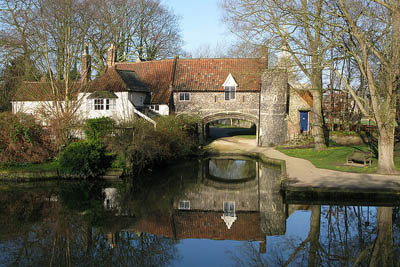
Other Historic Buildings in Norwich
The City has scores of other historic buildings and medieval structures that should not be missed on any account. The remains of the ancient wall that surrounded the city are still seen in the city centre, perfectly well preserved in many places. Some of these structures are Black Tower on the King Street, which was used to give clear over the southern approaches to the city. This building looks quite siniter in appearance considering its usage as a prison and as isolation house for plague victims.
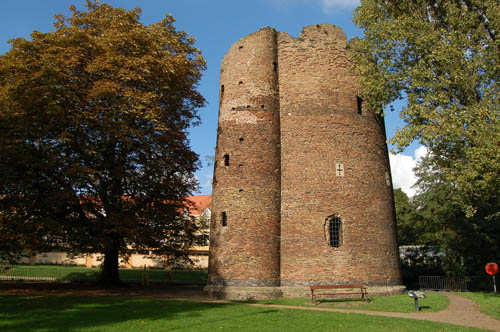
Another remnant of the city's old defences is the Cow Tower situated on the bend of the River Wensum, quite close to the Cathedral. It is a rare
example of a free-standing defensive tower. Ereccted first in 1278, was then rebuilt at the end of the 14th century. The remains of fireplaces and privies can still be seen inside. In later years, the tower served as a shelter for cows grazing on nearby meadows.
The Music House in King Street is the oldest domestic residential house in the Norwich. Built in 1175 by Isaac Jurnet, a Jewish merchant, it was used for music rehearsals from 16th to 18th century, hence the name Music House. Close by one can visit the Dragon Hall which is the only known surviving medieval trading hall in the Western Europe. It contains an intricately carved and painted emblem of a dragon among its roof beams, lending its name to the Hall.
The Great Hospital in Bishopsgate, founded by Bishop Suffield in 1249, is attached to St. Helen's Church.
St. Andrew's and Blackfriars Halls were originally part of a friary. Behind the halls stand part of the surviving cloisters and there is also a vaulted crypt. The halls are used for concerts, festivals and crafts fairs. I was lucky enough to visit the St. Andrew's on a sunday and was able to buy some really beautiful and exquisite gifts for my friends from one such crafts fair!
Elm Hill is a cobbled lane of timber-framed houses in which wealthy merchants lived from early 16th through late 18th centuries. By 1920s, they were so run down and unsafe to live that it was decided to demolish them all. Only a casting vote by the Lord Mayor averted this disaster. The houses were then systematically restored later on and the houses now serve as sets for many films and television productions.
The grand Georgian Assembly House in Theatre Street was built as public rooms in 1754, destroyed by fire in 1995, it has been restored lovingly to past glory and now continues to host exhibitions, concerts and meetings for many local societies. It was originally built to provide ballrooms for enjoyment of the local gentry.
The City Hall with its beautiful clock tower was built in 1930s and was opened by George VI. Its Scandinavian design also shows influences of Egyptian styles which were currently in fashion then after the discovery of Tutankhamen's tomb. When it was new, its orange colour led it to be known locally as the 'marmalade hall'.
Churches of Norwich
In the medieval times, Norwich had 57 churches within the city walls of which 31 still exist. Most are Perpendicular in style and are built from locallly procured flintstone. The main ones are, St. Peter Mancroft - the largest church in Norwich, was built between 1430 and 1455, dominates the city centre. St. Andrew's is the second largest church in Norwich and St. Giles has the tallest parish church tower in the city. Other notable churches are the Old Meeting House off Colegate, the Octagon, and St. John The Baptist.
Only ten of the medieval churches are now used as places of worship and the others are now used for other purposes such as arts venues, antiques markets, science centres and other Christian activities.
Museums and Galleries
Apart from the Norman Castle museum, there are many other museums to explore such as the Bridewell Museum, a former merchant's house dating back to 1325. It used to be a prison from vagrants and women - hence the name bridewell. It has displays of textiles, footwear industries, brewing, mustard production and chocolate making. The Bridewell has a lovingly reconstructed old pharmacy on display.
The City of Norwich Aviation Museum covers the history of aviation in Norfolk. Visitors can look round the cockpits of many aircrafts including a Vulcan bomber from the Falklands Task Force.
The Royal Norfolk Regimental Museum follows the story of local soldiers since 17th century. Displays include two of the six Victoria Crosses awarded to the members of the regiment, and a variety of badges, weapons and other items, including a 9 feet long Tibetan trumpet brought back from an expedition in 1903-1904.
Forum, also called as the Millenium Building, in the city centre houses Origins, a multimedia display dedicated to showing how the city and its environs have shaped over the last 2000 years.
John Jarrold Printing Museum celebrates the local printing industry.
Besides these, the other place where one explore the hsitory and culture of the city is the Stranger's Hall.
For art scene in Norwich, one can visit the various galleries such as the Norwich gallery on St. George's Street, Sainsbury Centre for Visual Arts, the King of Hearts, and the Norwich Arts Centre.
Events and Entertainment in Norwich
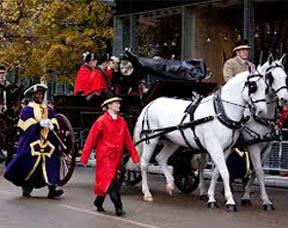 Norwich has something to offer to people having all tastes ranging from theatre, jazz, clasical concerts, dance, comedy etc. There is Norfolk and Norwich Festival held in the month of May inviting international stars to perform in various recitals, concerts, cabaret etc. The Lord Mayor's Street Procession is held in the beginning of July which is rounded off with a spectacular firework display. The City Council also organises Theatre in the Parks and a three-day music festival in Chapelfield Gardens every summer, as well as a spectacular firework show to celebrate the Bonfire Night in November.
Norwich has something to offer to people having all tastes ranging from theatre, jazz, clasical concerts, dance, comedy etc. There is Norfolk and Norwich Festival held in the month of May inviting international stars to perform in various recitals, concerts, cabaret etc. The Lord Mayor's Street Procession is held in the beginning of July which is rounded off with a spectacular firework display. The City Council also organises Theatre in the Parks and a three-day music festival in Chapelfield Gardens every summer, as well as a spectacular firework show to celebrate the Bonfire Night in November.
The Theatre Royal attracts leading artists and companies from across the world to stage finest productions that range from operas, ballets, and play that cater to all ages. The Maddermarket Theatre has been the home of the Norwich Players for 75 years. Other places for interesting events are the Norwich Playhouse, Norwich Puppet Theatre, Cinema City, and the University of East Anglia.
Besides these, Norwich Arts centre too presents a variety of programmes of music, dance, comedy and cabaret. King of Hearts hosts musical events, story telling and poetry reading events.
Streetlife and Shopping in Norwich
The streets bustle with life on weekdays and on saturdays, one can see a variety of musicians and string quartets performing at the city centre. It is really delightful to look at them and listen to the lively music ranging from skiffle bands to South American pan pipe players entertaining the shoppers.
There are more than 200 pubs in the city offering a diverse range of impressive food, there are many restaurants serving exlusive Indian food. surprisingly, the most favoured and loved dish in England is the Indian Chicken tikka! I was really very proud when I learned about this bit of info and when I went lunching with my colleagues at office, I was able to regale them with stories of Indian curries and masalas!
There is a city centre market open evey day except sunday, sporting gay coloured awnings, selling everything from fresh fruit and vegetables to books, leather bags, boots and whatever you may need. Beyond this market, the Gentleman's Walk has shops selling slothes, shoes, books and jewelery. Halfway along this walk is the Royal Arcade housing specialised shops that sell a variety of chocolates, mustard, gifts and toys etc.
Castle Mall situated below the mound on which the Norman Castle is built, is a modern shopping complex is quite an imaginative structure. It has major stores, restaurants, cafes and other facilities including a multiplex cinema. There is a long glass gallery that provides natural light to all the three shopping levels and overlooks the castle. Pottergate houses small craft and specialist shops. Elm Hill has stores that sell gifts, toys, paintings, antiques and various collectibles. Nearby Tombland sports cafes, restaurants, historic pubs and has shops selling books, antiques and jewelery.
Places Around Norwich
Norwich is situated on a bend in the River Wensum and in the medieval times, East Anglia was isolated by marshes and fenland (low-lying wet land with grassy vegetation). Boats used to ply on these waters carrying goods for breweries, textile industries and brought cotton, silk and wood for the city. Now the river is used mainly for leisure purposes and has a Yacht Station for mooring the cruisers. The Riverside Walk allows the pedestrians to walk beside the river in peaceful surroundings through the city centre. And believe me, the water does not stink!
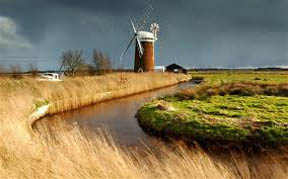
The Broads surrounding the River Wensum and the River yare is home to a number of insect species such as the rare Swallowtail butterflies and is a favorite place of the birdwatchers. These Broads are now recognised as a National Park. The Norfolk Wherry Albion, which once plied on these waters carrying commercial supplies, now is used for pleasure trips and educational outings in the Broads. Norwich also has a regular riverbus which trips from the heart of the city to the Broads during summers. The Swan at Horning beside the river is a very popular and famous pub.
Many boatyards in the Broads offer a chance to hire boats on daily basis. Besides, there are many attractive chalets and other riverside pubs one can visit. Nearby is Wroxham, a major Broads holiday centre.
How to Reach Norwich
There are regular trains operating from London to Norwich, starting from Liverpool Street, London. Norwich International Airport is situated four miles from the city and is well connected to a number of destinations in Europe and within UK. Besides, National Express Coaches ply between Norwich and London, other major cities in UK and to and from the main international airports of Heathrow, Stansted and Gatwick.
Best Season to Visit Norwich
Best time to visit this charming and beautiful city is from spring to summer when the climate is pleasant and there is no chilling cold. The trees are all beginning to shade to their winter blues and don the lovely greens of the summer. This is the time when the people go all out to practise their gardening skills and one can see a colourful profusion of flowers in every direction you turn your head, right from the flowerpots placed on the sidewalks and the middle of the footpaths, outside train station, outside the charming cottages, they are everywhere!
Only a word of caution, carry an umbrella or a raingear, as it rains any time, any day! You never know when you will be caught in the heavy showers, they are so unpredictable!
Like it on Facebook, Tweet it or share this article on other bookmarking websites.

